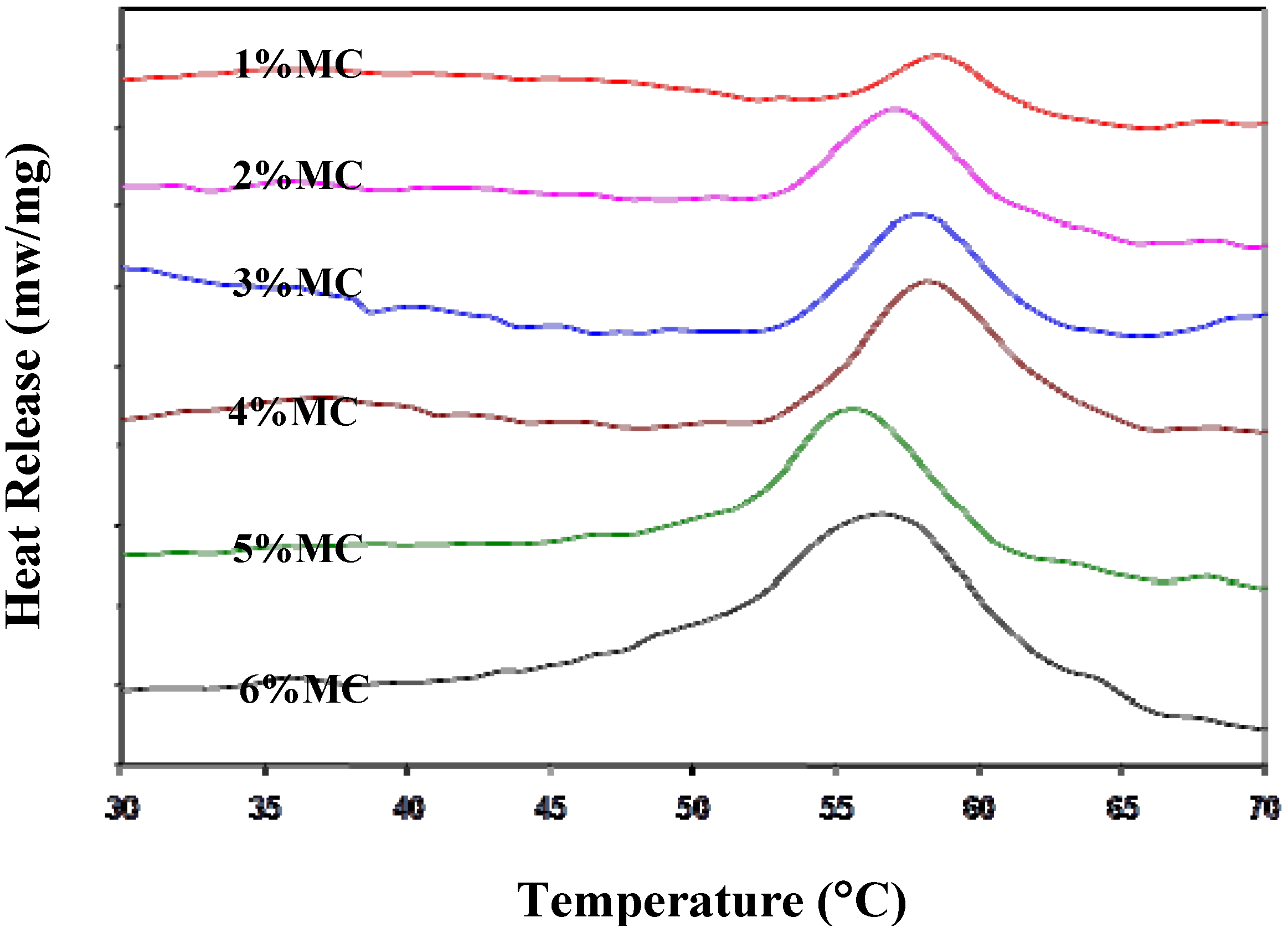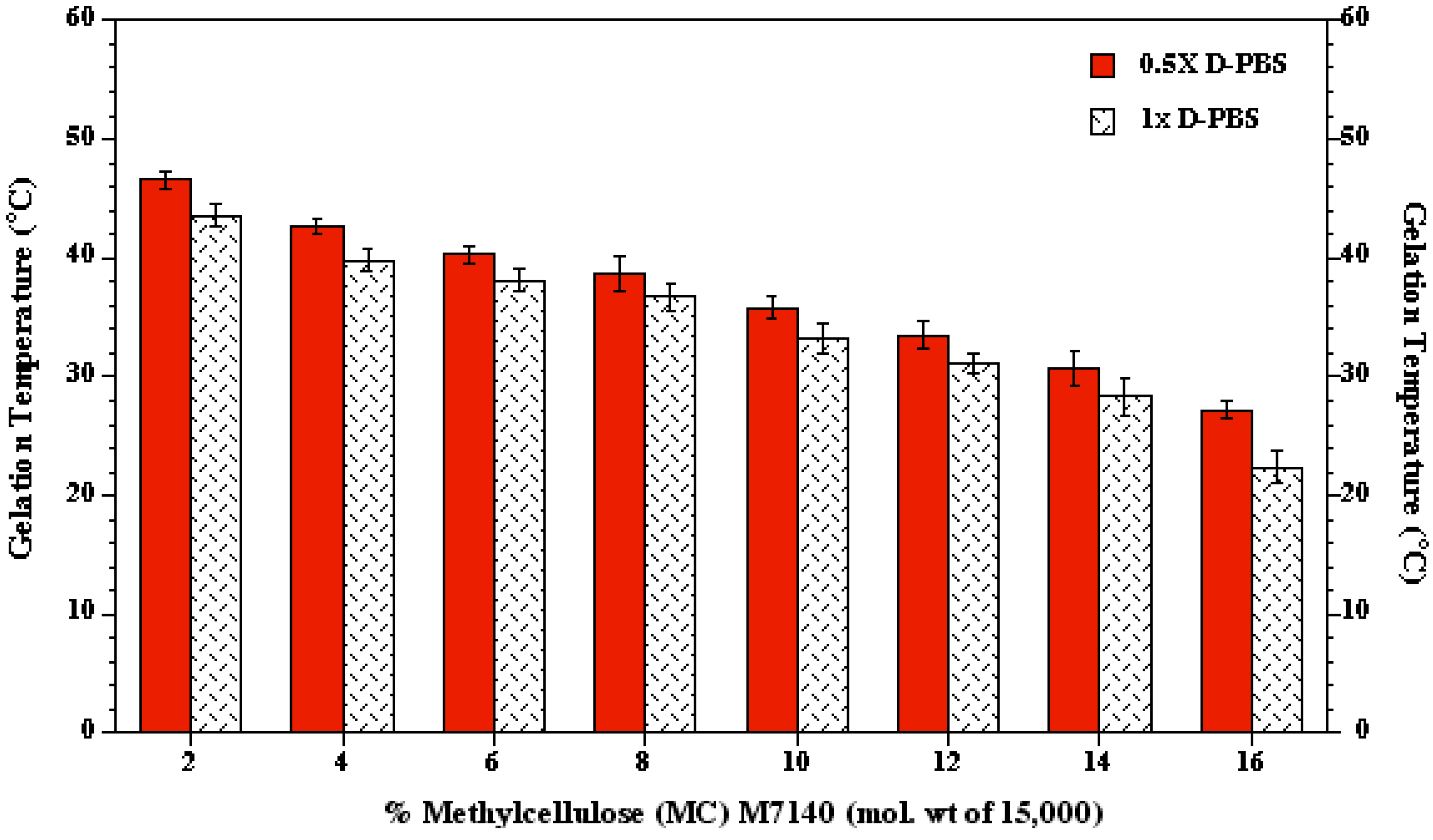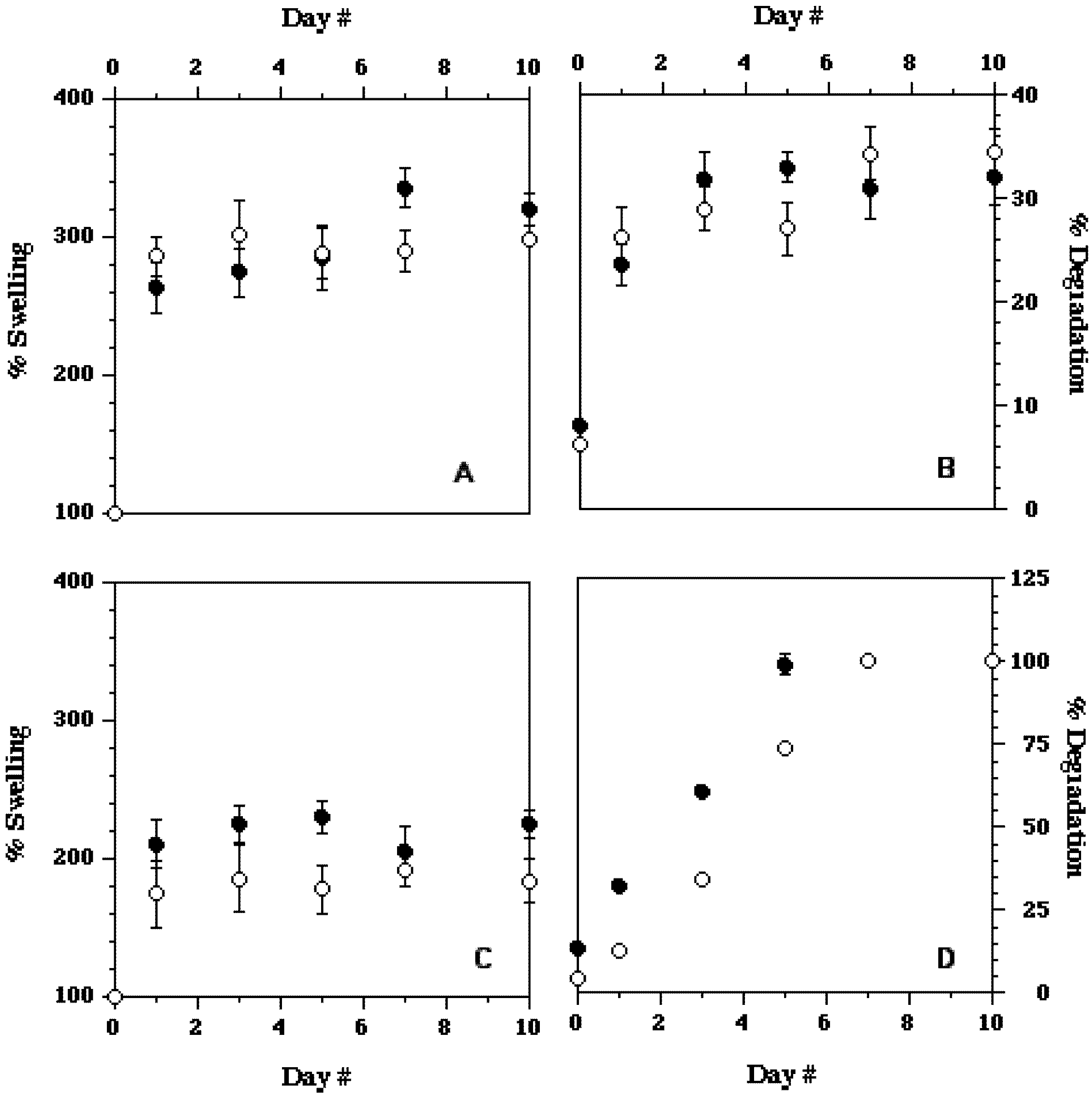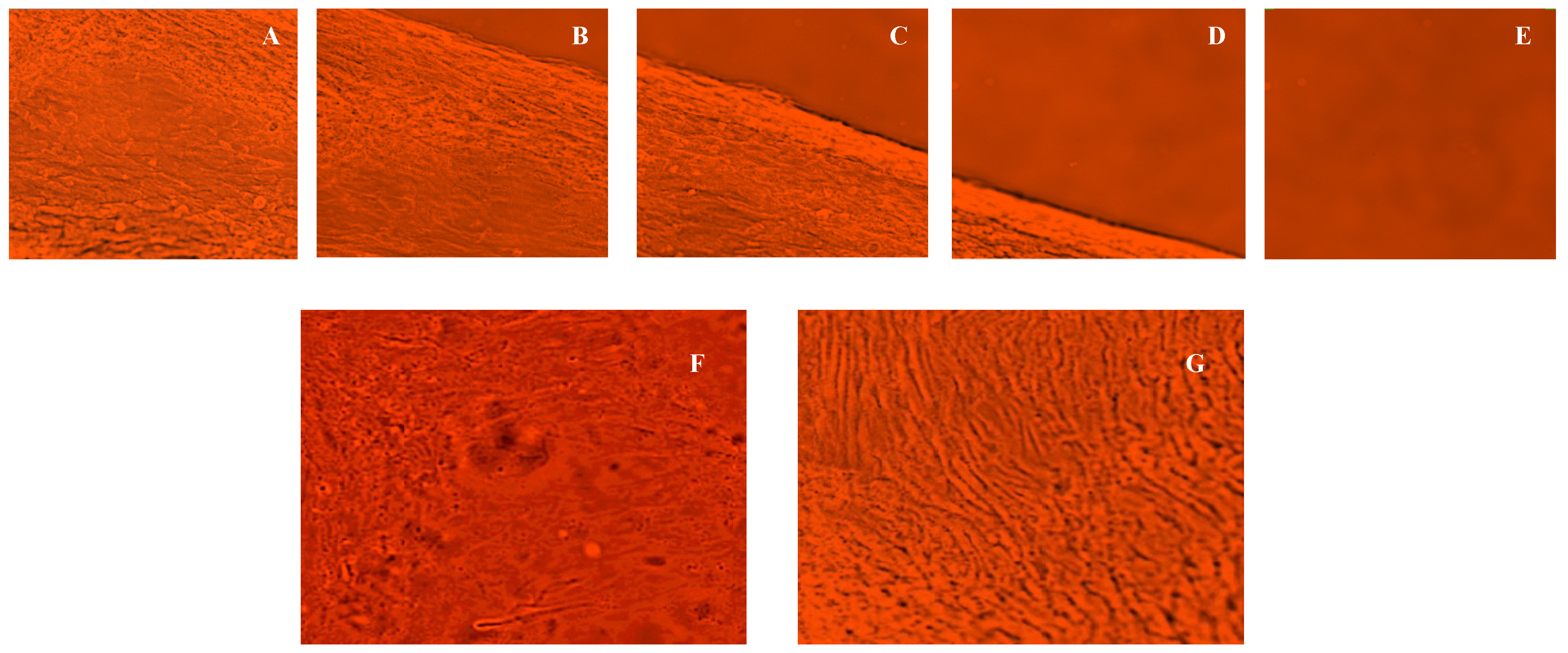Methylcellulose Based Thermally Reversible Hydrogel System for Tissue Engineering Applications
Abstract
:1. Introduction
2. Experimental Section
| Present Study | Chen et al. [24] | |||
|---|---|---|---|---|
| MC | M0512 (MW = 88,000) | M0262 (MW = 41,000) | M7140 (MW = 15,000) | Methocel 64630 (MW = 77000-94000) |
| MCConcentration (%) | 1,2,3,4,5,6 | 2,4,6,8,10 | 2,4,6,8,10,12,14,16 | 1,2,3,4 |
| Salts | D-PBS | D-PBS | D-PBS | NaCl, Na2SO4, Na3-PO4, D-PBS |
| Salt Concentrations (Moles) | 0M,0.3M,0.6M,0.9M,1.2M,1.5M,1.8M | 0M, 0.15M, 0.3M | 0M, 0.15M, 0.3M | 0M,0.1M,0.2M,0.4M,0.6M,0.8M,1.0M |
2.1. Preparation of MC-Aqueous Solutions
| MC Concentration (%) | Gel Point from Calorimetry Experiments (°C) | ||
|---|---|---|---|
| M0512 (mol. wt. = 88,000) | M0262 (mol. wt. = 41,000) | M7140 (mol. wt. = 15,000) | |
| 2 | 53.1 (±0.8) | 52.5 (±0.3) | 50.8 (±0.7) |
| 4 | 52.2 (±1.3) | 48.2 (±1.1) | 46.4 (±1.9) |
| 6 | 48.2 (±1.0) | 45.8 (±1.4) | 44.9 (±1.5) |
| 8 | — | 43.2 (±1.4) | 44.1 (±0.9) |
| 10 | — | 41.7 (±2.0) | 40.1 (±1.2) |
| 12 | — | — | 37.6 (±0.8) |
| 14 | — | — | 34.6 (±1.9) |
| 16 | — | — | 31.1 (±1.5) |
2.2. Calorimetric Characterization of Aqueous MC Solutions
2.3. Preparation of the MC Hydrogel Coated Tissue Culture Polystyrene (TCPS) Dish

2.4. In vitro Degradation, Swelling and Osmotic Stability of MC Gels

2.5. Culture of ASCs on MC Coated TCPS Dishes
3. Results and Discussion
3.1. Effect of Molecular Weight

3.2. Effect of Salt Concentration and Osmolality
3.3. Optimal MC Concentration

3.4. Effect of Culture Time—Degradation/Swelling

3.5. Further Optimization of the Thermally Reversible Hydrogel System for ASC Culture
3.6. Thermal Reversibility of Attachment—Effect of Temperature
3.7. Multi-Dimensional Cell Sheets


4. Conclusions
Acknowledgements
Conflict of Interest
References
- Yang, J.; Yamato, M.; Kohno, C.; Nishimoto, A.; Sekine, H.; Fukai, F.; Okano, T. Cell sheet engineering: Recreating tissues without biodegradable scaffolds. Biomaterials 2005, 26, 6415–6422. [Google Scholar] [CrossRef]
- Muschler, G.F.; Nakamoto, C.; Griffith, L.G. Engineering principles of clinical cell-based tissue engineering. J. Bone Joint Surg. Am. 2004, 86, 1541–1558. [Google Scholar]
- Sittinger, M.; Bujia, J.; Rotter, N.; Reitzel, D.; Minuth, W.W.; Burmester, G.R. Tissue engineering and autologous transplant formation: Practical approaches with resorbable biomaterials and new cell culture techniques. Biomaterials 1996, 17, 237–242. [Google Scholar] [CrossRef]
- Hubbell, J.A.; Massia, S.P.; Desai, N.P.; Drumheller, P.D. Endothelial cell-selective materials for tissue engineering in the vascular graft via a new receptor. Biotechnology 1991, 9, 568–572. [Google Scholar] [CrossRef]
- Griffith, L.G.; Naughton, G. Tissue engineering: Current challenges and expanding opportunities. Science 2002, 295, 1009–1014. [Google Scholar] [CrossRef]
- Griffith, L.G. Emerging design principles in biomaterials and scaffolds for tissue engineering. Ann. N. Y. Acad. Sci. 2002, 961, 83–95. [Google Scholar] [CrossRef]
- Bauer, T.W.; Muschler, G.F. Bone graft materials. An overview of the basic science. Clin. Orthop. Relat. Res. 2000, 371, 10–27. [Google Scholar] [CrossRef]
- Sikavitsas, V.I.; Bancroft, G.N.; Mikos, A.G. Formation of three-dimensional cell/polymer constructs for bone tissue engineering in a spinner flask and a rotating wall vessel bioreactor. J. Biomed. Mater. Res. 2002, 62, 136–148. [Google Scholar] [CrossRef]
- Kumar, P.R.A.; Varma, H.K.; Kumary, T.V. Cell patch seeding and functional analysis of cellularized scaffolds for tissue engineering. Biomed. Mater. 2007, 2, 48–54. [Google Scholar] [CrossRef]
- Kumar, P.R.A.; Sreenivasan, K.; Kumary, T.V. Alternate method for grafting thermoresponsive polymer for transferring in vitro cell sheet structures. J. Appl. Polym. Sci. 2007, 105, 2245–2251. [Google Scholar] [CrossRef]
- Avgoustiniatos, E.S.; Colton, C.K. Effect of external oxygen mass transfer resistances on viability of immunoisolated tissue. Ann. N. Y. Acad. Sci. 1997, 831, 145–167. [Google Scholar] [CrossRef]
- Hutmacher, D.W. Scaffolds in tissue engineering bone and cartilage. Biomaterials 2000, 21, 2529–2543. [Google Scholar] [CrossRef]
- Sistino, J.J. Bioreactors for tissue engineering—A new role for perfusionists? J. Extra Corpor. Technol. 2003, 35, 200–202. [Google Scholar]
- Martin, I.; Wendt, D.; Heberer, M. The role of bioreactors in tissue engineering. Trends Biotechnol. 2004, 22, 80–86. [Google Scholar] [CrossRef]
- Janssen, F.W.; Oostra, J.; Oorschot, A.; van Blitteswijk, C.A. A perfusion bioreactor system capable of producing clinically relevant volumes of tissue-engineered bone: In vivo bone formation showing proof of concept. Biomaterials 2006, 27, 315–323. [Google Scholar] [CrossRef]
- Dvir, T.; Benishti, N.; Shachar, M.; Sohen, S. Novel perfusion bioreactor providing a homogenous milieu for tissue regeneration. Tissue Eng. 2006, 12, 2843–2852. [Google Scholar] [CrossRef]
- Khong, Y.M.; Zhang, J.; Zhou, S.; Cheung, C.; Doberstein, K.; Samper, V.; Yu, H. Novel intra-tissue perfusion system for culturing thick liver tissue. Tissue Eng. 2007, 13, 2345–2356. [Google Scholar] [CrossRef]
- Yamato, M.; Utsumi, M.; Kushida, A.; Konno, C.; Kikuchi, A.; Okano, T. Thermo-responsive culture dishes allow the intact harvest of multilayered keratinocyte sheets without dispase by reducing temperature. Tissue Eng. 2001, 7, 473–480. [Google Scholar] [CrossRef]
- Yamao, M. Cell sheet engineering: from temperature-responsive culture surfaces to clinics. In European Cells and Materials: Biosurf. V - Functional Polymeric Surfaces in Biotechnology; ETH: Zürich, Switzerland, 2003; pp. 26–27. [Google Scholar]
- Shimizu, T.; Sekine, H.; Yang, J.; Isoi, Y.; Yamato, M.; Kikuchi, A.; Kobayashi, E.; Okano, T. Polysurgery of cell sheet grafts overcomes diffusion limits to produce thick, Vascularized myocardial tissues. FASEB J. 2006, 20, 708–710. [Google Scholar]
- Hayashida, Y.; Nishida, K.; Yamato, M.; Yang, J.; Sugiyama, H.; Watanabe, K.; Hori, Y.; Maeda, N.; Kukuchi, A.; Okano, T.; et al. Transplantation of tissue-engineered epithelial cell sheets after excimer laser photoablation reduces postoperative corneal haze. Invest. Ophthalmol. Vis. Sci. 2006, 47, 552–557. [Google Scholar] [CrossRef]
- Akiyama, Y.; Kushida, A.; Yamato, M.; Kikuchi, A.; Okano, T. Surface characterization of Poly(N-Isopropylacrylamide) grafted tissue culture polystyrene by electron beam irradiation, Using atomic force microscopy, And X-ray photoelectron spectroscopy. J. Nanosci. Nanotechnol. 2007, 7, 796–802. [Google Scholar] [CrossRef]
- Matsuda, N.; Shimizu, T.; Yamato, M.; Okano, T. Tissue engineering based on cell sheet technology. Adv. Mater. 2007, 19, 3089–3099. [Google Scholar] [CrossRef]
- Chen, C.H.; Tsai, C.C.; Chen, W.; Mi, F.L.; Liang, H.F.; Chen, S.C.; Sung, H.W. Novel living cell sheet harvest system composed of thermoreversible methylcellulose hydrogels. Biomacromolecules 2006, 7, 736–743. [Google Scholar] [CrossRef]
- Li, L.; Shan, H.; Yue, C.Y.; Lam, Y.C.; Tam, K.C.; Hu, X. Thermally induced association and dissociation of methylcellulose in aqueous solutions. Langmuir 2002, 18, 7291–7298. [Google Scholar] [CrossRef]
- Zheng, P.; Li, L.; Hu, X.; Zhao, X. Sol-gel transition of methylcellulose in phosphate buffer saline solutions. J. Polym. Sci., Part. B: Polym. Phys. 2004, 42, 1849–1860. [Google Scholar] [CrossRef]
- Tate, M.C.; Shear, D.A.; Hoffman, S.W.; Stein, D.G.; LaPlaca, M.C. Biocompatibility of methylcellulose-based constructs designed for intracerebral gelation following experimental traumatic brain injury. Biomaterials 2001, 22, 1113–1123. [Google Scholar] [CrossRef]
- Zuk, P.A.; Zhu, M.; Mizuno, H.; Huang, J.; Futrell, J.W.; Katz, A.J.; Benjaim, P.; Lorenz, H.P.; Hedrick, M.H. Multilineage cells from human adipose tissue: Implications for cell-based therapies. Tissue Eng. 2001, 7, 211–228. [Google Scholar] [CrossRef]
- Gimble, J.; Guilak, F. Adipose-derived adult stem cells: Isolation, Characterization, and differentiation potential. Cytotherapy 2003, 5, 362–369. [Google Scholar] [CrossRef]
- Thirumala, S.; Gimble, J.M.; Devireddy, R.V. Transport phenomena during freezing of adipose tissue derived adult stem cells. Biotechnol. Bioeng. 2005, 92, 372–383. [Google Scholar] [CrossRef]
- Thirumala, S.; Zvonic, S.; Floyd, E.; Gimble, J.M.; Devireddy, R.V. The effect of various freezing parameters on the immediate post-thaw membrane integrity of adipose tissue derived adult stem cells. Biotech. Prog. 2005, 21, 1511–1524. [Google Scholar] [CrossRef]
- Mitchell, J.B.; McIntosh, K.; Zvonic, S.; Garrett, S.; Floyd, Z.E.; Kloster, A.; Di Halvorsen, Y.; Storms, R.W.; Goh, B.; Kilroy, G.; et al. Immunophenotype of human adipose-derived cells: Temporal changes in stromal-associated and stem cell-associated markers. Stem Cells 2006, 24, 376–385. [Google Scholar] [CrossRef]
- Gimble, J.M.; Katz, A.J.; Bunnell, B.A. Adipose-derived stem cells for regenerative medicine. Circ. Res. 2007, 100, 1249–1260. [Google Scholar] [CrossRef]
- Ford, J.L. Thermal analysis of hydroxypropylmethylcellulose and methylcellulose: Powders, Gels and matrix tablets. Int. J. Pharm. 1999, 179, 209–228. [Google Scholar] [CrossRef]
- Sarkar, N. Thermal gelation properties of methyl and hydroxypropyl methylcellulose. J. Appl. Polym. Sci. 1979, 24, 1073–1087. [Google Scholar] [CrossRef]
- Sarkar, N.; Walker, L.C. Hydration-dehydration properties of methylcellulose and hydroxypropylmethylcellulose. Carbohydr. Polym. 1995, 27, 177–185. [Google Scholar] [CrossRef]
- Heymann, E. Studies on sol-gel transformations. I. The inverse sol-gel transformation of methylcellulose in water. Trans. Faraday Soc. 1935, 31, 846–864. [Google Scholar] [CrossRef]
- Wang, Q.; Li, L. Effects of molecular weight on thermoreversible gelation and gel elasticity of methylcellulose in aqueous solution. Carbohydr. Polym. 2005, 62, 232–238. [Google Scholar] [CrossRef]
- Xu, Y.; Wang, C.; Tam, K.C.; Li, L. Salt-assisted and salt-suppressed sol-gel transitions of methylcellulose in water. Langmuir 2004, 20, 646–652. [Google Scholar] [CrossRef]
- Procter, H.R. The equilibrium of dilute hydrochloric acid and gelatin. J. Chem. Soc. Trans. 1914, 105, 313–327. [Google Scholar] [CrossRef]
- Grignon, J.; Scallan, A.M. Effect of pH and neutral salts upon the swelling of cellulose gels. J. Appl. Polym. Sci. 1980, 25, 2829–2843. [Google Scholar] [CrossRef]
- Galaev, I.Y.; Mattiasson, B. ‘Smart’ polymers and what they could do in biotechnology and medicine. Trends Biotech. 1999, 8, 335–340. [Google Scholar] [CrossRef]
- Hirose, M.; Kwon, O.H.; Yamato, M.; Kikuchi, A.; Okano, T. Creation of designed shape cell sheets that are noninvasively harvested and moved onto another surface. Biomacromolecules 2000, 1, 377–381. [Google Scholar] [CrossRef]
- Tanga, Z.; Kikuchi, A.; Akiyamaa, Y.; Okano, T. Novel cell sheet carriers using Polyion complex gel modified membranes for tissue engineering technology for cell sheet manipulation and transplantation. React. Funct. Polym. 2007, 67, 1388–1397. [Google Scholar] [CrossRef]
- Harimoto, M.; Yamato, M.; Hirose, M.; Takahashi, C.; Isoi, Y.; Kikuchi, A.; Okano, T. Novel approach for achieving double-layered cell sheets co-culture: Overlaying endothelial cell sheets onto monolayer hepatocytes utilizing temperature-responsive culture dishes. J. Biomed. Mater. Res. 2002, 62, 464–470. [Google Scholar] [CrossRef]
- Shimizu, T.; Yamato, M.; Kikuchi, A.; Okano, T. Cell sheet engineering for myocardial tissue reconstruction. Biomaterials 2003, 24, 2309–2316. [Google Scholar] [CrossRef]
- Nishida, K.; Yamato, M.; Hayashida, Y.; Watanabe, K.; Maeda, N.; Watanabe, H.; Yamamoto, K.; Nagai, S.; Kikuchi, A.; Tano, Y.; et al. Functional bioengineered corneal epithelial sheet grafts from corneal stem cells expanded ex vivo an a temperature-responsive cell culture surface. Transplantation 2004, 77, 379–385. [Google Scholar] [CrossRef]
- Akizuki, T.; Oda, S.; Komaki, M.; Tsuchioka, H.; Kawakatsu, N.; Kikuchi, A.; Yamato, M.; Okano, T.; Ishikawa, I. Application Of periodontal ligament cell sheet for periodontal regeneration: A pilot study in beagle dogs. J. Periodontal. Res. 2005, 40, 245–251. [Google Scholar] [CrossRef]
- Ide, T.; Nishida, K.; Yamato, M.; Sumide, T.; Utsumi, M.; Nozaki, T.; Kikuchi, A.; Okano, T.; Tano, Y. Structural characterization of bioengineered human corneal endothelial cell sheets fabricated on temperature-responsive culture dishes. Biomaterials 2006, 27, 607–614. [Google Scholar] [CrossRef]
- Vermette, M.; Trottier, V.; Menard, V.; Saint-Pierre, L.; Roy, A.; Fradette, J. Production of A new tissue-engineered adipose substitute from human adipose-derived stromal cells. Biomaterials 2007, 28, 2850–2860. [Google Scholar] [CrossRef]
- Obokata, H.; Yamato, M.; Yang, J.; Nishida, K.; Tsuneda, S.; Okano, T. Subcutaneous transplantation of autologous oral mucosal epithelial cell sheets fabricated on temperature-responsive culture dishes. J. Biomed. Mater. Res. Part A 2008, 86, 1088–1096. [Google Scholar]
- Larouche, D.; Paquet, C.; Fradette, J.; Carrier, P.; Auger, F.A.; Germain, L. Regeneration of skin and cornea by tissue engineering. Meth. Mol. Biol. 2009, 482, 233–256. [Google Scholar] [CrossRef]
- Labbe, B.; Marceau-Fortier, G.; Fradette, J. Cell sheet technology for tissue engineering: The self-assembly approach using adipose-derived stromal cells. Meth. Mol. Biol. 2011, 702, 429–441. [Google Scholar] [CrossRef]
- Fortier, G.M.; Gauvin, R.; Proulx, M.; Vallee, M.; Fradette, J. Dynamic culture induces a cell-type dependent response impacting on the thickness of engineered constructive tissue. J. Tissue Eng. Regen. Med. 2013, 7, 292–301. [Google Scholar] [CrossRef]
© 2013 by the authors; licensee MDPI, Basel, Switzerland. This article is an open access article distributed under the terms and conditions of the Creative Commons Attribution license (http://creativecommons.org/licenses/by/3.0/).
Share and Cite
Thirumala, S.; Gimble, J.M.; Devireddy, R.V. Methylcellulose Based Thermally Reversible Hydrogel System for Tissue Engineering Applications. Cells 2013, 2, 460-475. https://doi.org/10.3390/cells2030460
Thirumala S, Gimble JM, Devireddy RV. Methylcellulose Based Thermally Reversible Hydrogel System for Tissue Engineering Applications. Cells. 2013; 2(3):460-475. https://doi.org/10.3390/cells2030460
Chicago/Turabian StyleThirumala, Sreedhar, Jeffrey M. Gimble, and Ram V. Devireddy. 2013. "Methylcellulose Based Thermally Reversible Hydrogel System for Tissue Engineering Applications" Cells 2, no. 3: 460-475. https://doi.org/10.3390/cells2030460




